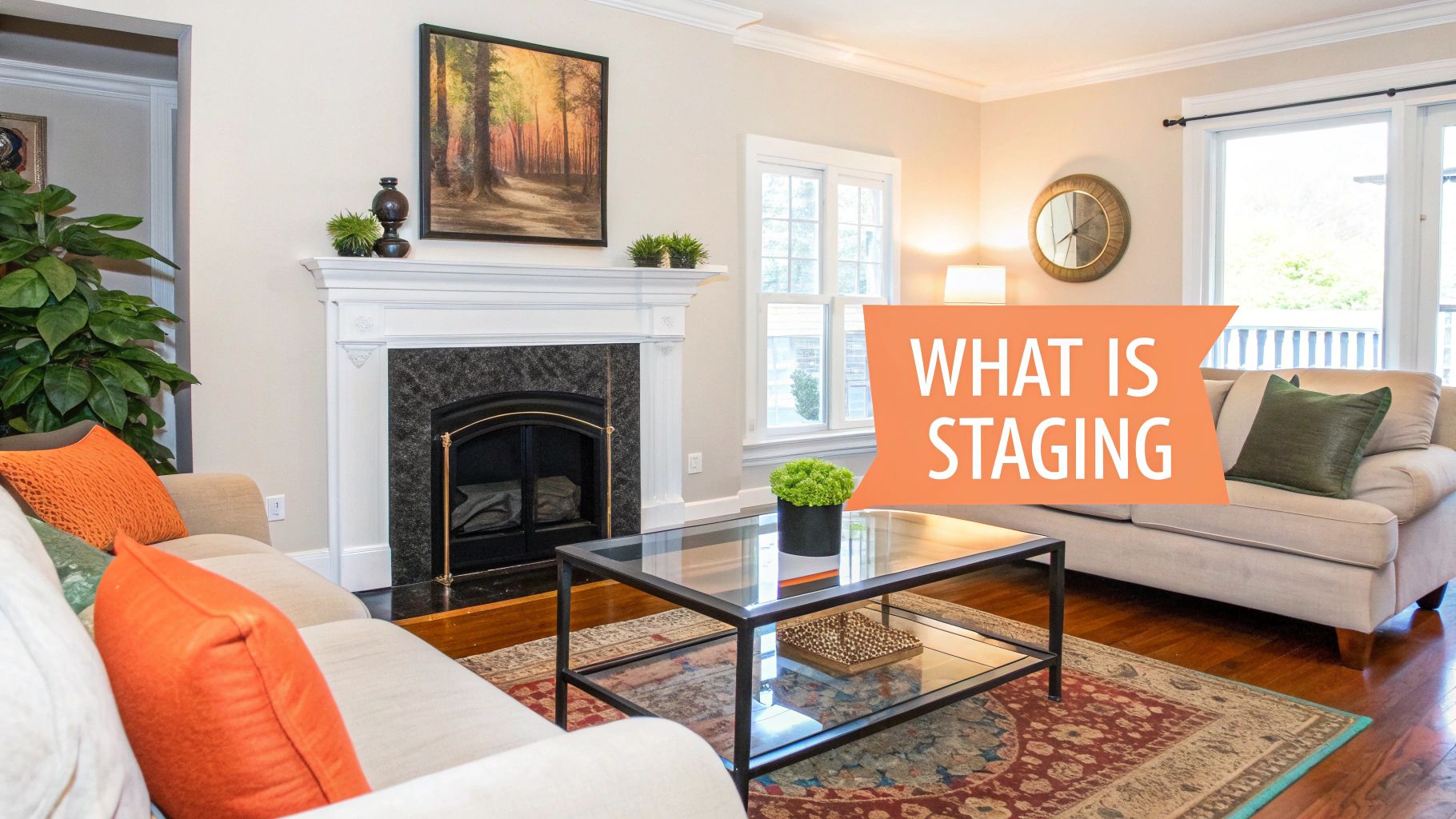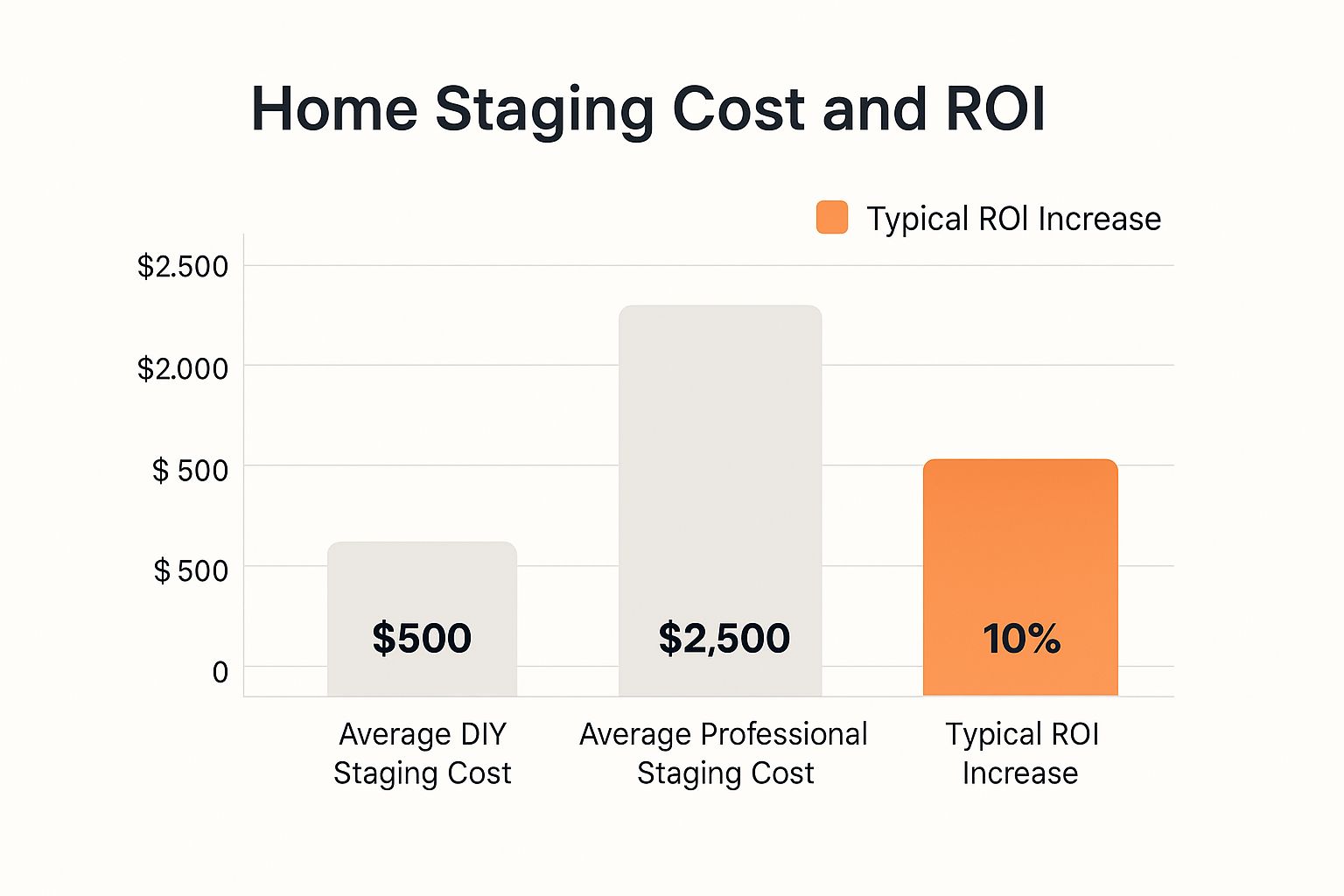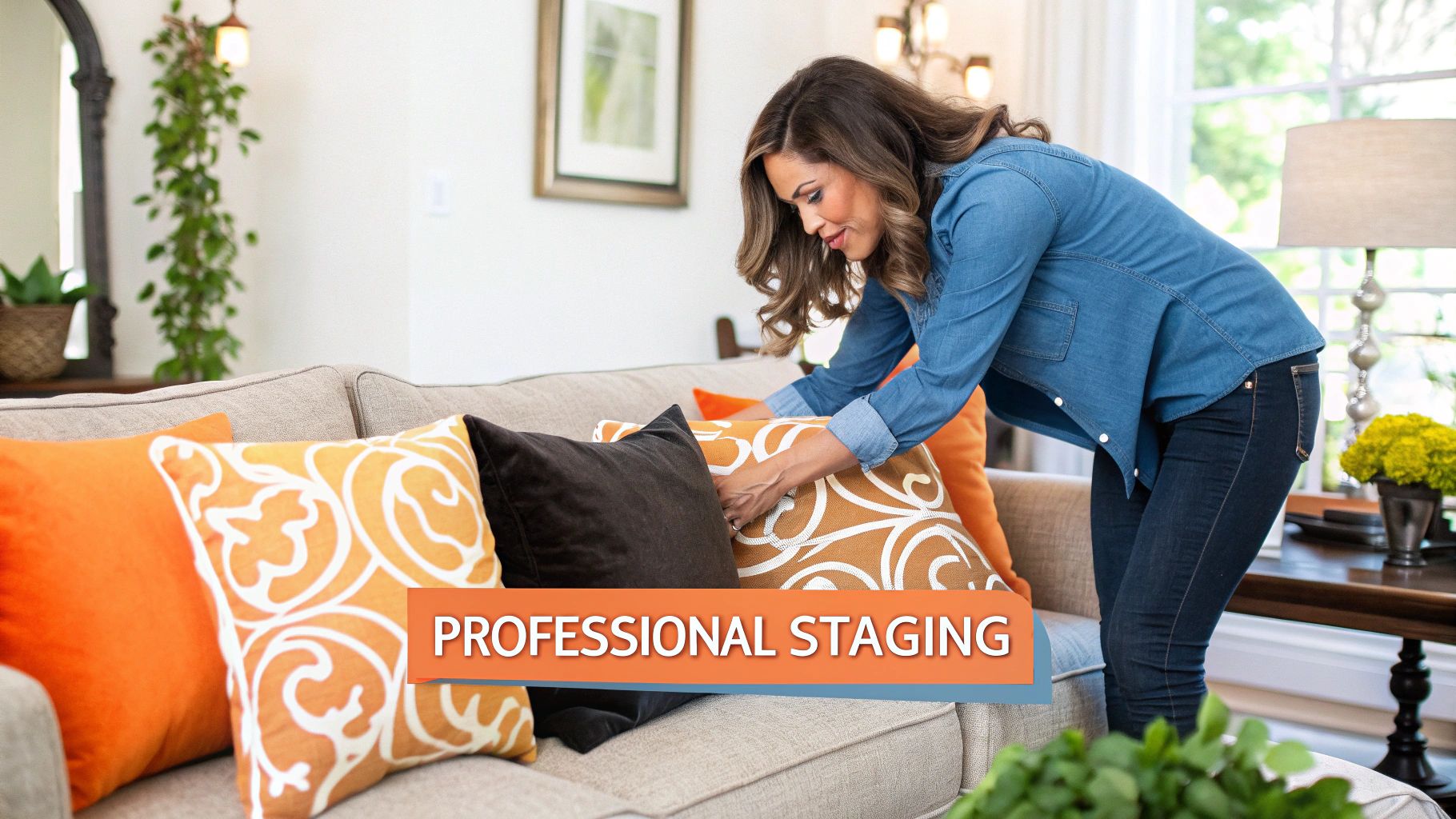What Is House Staging? The Complete Guide to Selling Faster
Discover what house staging is and transform your home sale. Learn proven strategies from industry experts that help you attract buyers and sell faster.
What House Staging Really Means (Beyond The Furniture)

This Wikipedia image offers a great before-and-after look at the power of house staging. The "before" shot typically shows a lived-in space, full of personal touches. The "after," however, presents a neutral, inviting canvas designed to resonate with a wider range of potential buyers. This visual contrast highlights how staging can truly elevate a property's attractiveness, making it feel more spacious, bright, and desirable.
What exactly is house staging, though? It's more than simply arranging furniture and adding a few decorative pillows. It's about crafting an emotional connection with buyers. Think of it like setting the stage for a play. The script (the house itself) remains the same, but the performance is enhanced to captivate the audience (the buyers).
You're creating a narrative, allowing buyers to envision themselves living in the space. This involves depersonalizing enough to let their own lives take center stage, while simultaneously showcasing the home's strongest selling points.
A well-placed mirror, for example, can create the illusion of more space. Soft lighting paired with neutral paint colors establishes a calming and welcoming ambiance. Decluttering, meanwhile, allows buyers to appreciate the home's architecture and the potential of each room, rather than being distracted by personal items.
This isn't about masking your home's personality. It's about presenting it in the best possible light. It's about helping buyers fall in love with the potential they see.
The impact of home staging is backed by impressive numbers. According to the Real Estate Staging Association (RESA) , staged homes sell roughly 72% faster than unstaged homes. This speedier sale is partially due to the increased interest in staged properties, with 40% of buyers more inclined to visit a staged home they discovered online.
Want to dive deeper into the stats? Discover more insights on staging statistics here . These figures clearly demonstrate the advantage of staging in a competitive real estate market. Ready to get started? Check out our guide on home staging tips for practical advice on preparing your home for a swift and profitable sale.
The Psychology Behind Why Staging Creates Instant Attraction

This screenshot from the National Association of Realtors website highlights valuable resources for real estate professionals. The focus on providing data, research, and insights underscores the importance of understanding market trends. This aligns perfectly with the strategic approach of house staging, which uses market knowledge to maximize a property's appeal.
House staging isn't just about prettying up a space; it's about understanding the psychology of buyers. Think about the feeling of walking into a bright, airy room, decluttered and painted in calming neutrals. It almost instantly creates a sense of peace and spaciousness.
Now, imagine the opposite: a dimly lit, cluttered room with bold, jarring colors. The space feels smaller, more closed in, and can even trigger feelings of anxiety. This contrast highlights the core principle of house staging: creating an environment that resonates positively with potential buyers.
Neutral colors, for instance, tend to create a sense of calm, allowing buyers to focus on the home's features. Proper lighting plays a crucial role as well. A well-lit space feels inviting and open, while poor lighting can cast shadows and create a less appealing atmosphere.
Decluttering is another key element of staging. When personal items are minimized, the house becomes a blank canvas. Buyers can more easily envision their own belongings in the space, fostering a sense of ownership and connection.
Staging professionals also use psychological principles to their advantage. The halo effect, for example, describes how a strong first impression can positively influence overall perception. Imagine walking into a beautifully staged living room; that initial "wow" factor can set the tone for how buyers view the rest of the house. Another principle is anchoring, where an initial piece of information—like a stunning entryway—shapes subsequent judgments about the property. These techniques are essential to effective staging.
The Real Numbers: What Staging Investment Actually Returns
Investing in house staging might seem like an extra cost, but think of it more as a smart investment. It's all about maximizing your return. Imagine launching a new phone – you wouldn't do it without attractive packaging and advertising. Staging is your home's marketing plan, designed to draw in the best offers.
This means looking beyond the initial staging costs and considering the potential bump in your final sale price. For example, imagine spending $2,000 on staging and getting a 5%increase on a$400,000home. That's a**$20,000** profit – a substantial return on your initial investment.
Staging can also significantly reduce the time your house is on the market. Fewer days listed means lower carrying costs like mortgage payments, utilities, and property taxes. These savings quickly add up, further boosting your overall return. Imagine staging saves you a month of selling time. That's a month of mortgage payments saved, potentially thousands of dollars.
The Power of Multiple Offers
Moreover, a well-staged home often attracts multiple offers, sometimes leading to bidding wars. This competitive edge isn't just a nice bonus. House staging has become a key part of real estate, impacting both selling price and time on market. The National Association of Realtors (NAR) reports that almost 30%of agents saw a1% to 10% increase in offers after staging. For more on the power of staging, check out these insights .
To illustrate the financial benefits, let's look at a comparison table: Staging Investment vs. Return Comparison
- Breakdown of typical staging costs versus average return on investment across different home price ranges
| Home Price Range | Average Staging Cost | Typical ROI | Days on Market Reduction |
|---|---|---|---|
| $200,000 | $1,000 | 5-10% | 15-30 days |
| $400,000 | $2,000 | 5-15% | 20-45 days |
| $600,000 | $3,000 | 7-20% | 30-60 days |
This table demonstrates how staging costs are often a small fraction of the potential return, especially as home prices increase. The reduction in days on market further contributes to the financial benefits by minimizing carrying costs.
Finally, let's not forget the less tangible benefit: reduced stress. Staging can simplify the selling process, making it faster and less emotionally draining. This peace of mind is a valuable benefit in itself. Understanding the many advantages of staging empowers you to make informed decisions about your property and get the best possible outcome.
Strategic Room-By-Room Staging That Moves The Needle

This infographic breaks down the costs of DIY staging versus hiring a professional, and compares the potential return on investment. Notice how professional staging, while a bigger initial investment, can offer a substantial boost to your ROI. Think of it this way: even a small bump in perceived value, thanks to smart staging, can mean a significantly higher selling price.
When you're figuring out how to stage your house strategically, remember not all rooms hold the same weight with buyers. Some spaces simply make a bigger impression. By concentrating your efforts and budget on these key areas, you're getting the most bang for your buck. It's like creating a movie trailer – you showcase the best scenes to grab the audience's attention.
Prioritizing Your Staging Efforts
The living roomandkitchen are the heart of any home. These are where buyers imagine themselves living their daily lives, so making these spaces feel inviting and functional is essential. In the living room, arrange furniture to encourage conversation and highlight natural light and a sense of spaciousness. In the kitchen, decluttering is your best friend. Show off those countertops and any modern appliances.
The primary bedroom is another crucial space. Buyers want to feel a sense of calm and relaxation in their future bedroom. Creating a peaceful atmosphere with soft lighting, neutral colors, and a beautifully made bed can really make a difference.
Introducing a table showcasing the room priority and staging focus can be helpful here. This table provides a strategic overview of how to approach staging each room, considering both buyer impact and budget. Room Priority and Staging Focus Guide
- Strategic approach to staging different rooms based on buyer impact and budget allocation
| Room | Priority Level | Key Focus Areas | Average Budget % |
|---|---|---|---|
| Living Room | High | Conversational layout, natural light, spaciousness | 20% |
| Kitchen | High | Decluttering, counter space, modern appliances | 15% |
| Primary Bedroom | High | Calming atmosphere, soft lighting, neutral colors | 15% |
| Entryway | Medium | Clean, uncluttered, welcoming | 10% |
| Dining Room | Medium | Entertaining potential | 10% |
| Bathrooms | Low | Clean and tidy | 5% |
| Secondary Bedrooms | Low | Clean and tidy | 5% |
| Other Areas (Hallways, etc.) | Low | Clean and tidy | 20% |
This table emphasizes that high-impact areas like the living room, kitchen, and primary bedroom deserve the largest portion of your staging budget. However, don't neglect those seemingly less important spaces!
Maximizing Impact in Key Areas
Entryways and dining rooms shouldn't be overlooked. The entryway is the first impression, so make it clean, uncluttered, and welcoming. In the dining room, highlighting its potential for hosting gatherings can be a real selling point.
On the other hand, spaces like bathrooms and secondary bedrooms, while still important to present neatly, require less intensive staging. For more tips on prioritizing your efforts, check out our guide on how to stage an empty house .
Addressing Challenging Spaces
What about those tricky spots or outdated fixtures you can't easily change? Get creative! A strategically placed mirror can make a small room feel larger. A fresh coat of paint on an accent wall can distract from outdated features. Clever lighting can transform a dark space into something cozy and inviting. Remember, staging is all about showcasing the potential of your home, not achieving absolute perfection.
DIY Staging Vs. Hiring Professionals: Making The Smart Choice
So, you're getting ready to put your house on the market. One of the biggest decisions you'll face is whether to stage it yourself or bring in the pros. It's a bit like choosing to bake a cake from scratch or picking one up at a bakery. Both options can lead to a delicious outcome, but the time, cost, and final product will likely be quite different.
DIY staging can be a great option if you have a good sense of style, plenty of free time, and a budget you want to stick to. You might already enjoy rearranging furniture and know how to freshen up a room with a few simple touches, like strategically placed cushions. Decorating with cushions can add a touch of elegance and make a huge difference in the visual appeal of your home. This hands-on method allows you to personalize the space and keep costs down.
But DIY isn't always a walk in the park. It takes serious time and effort. Think about spending your weekends decluttering, repainting, and shopping for accessories instead of enjoying your downtime. You also need to honestly assess your skills and resources. Do you understand the core principles of house staging, such as creating flow and emphasizing a room's best features? Do you have access to furniture and decor that will resonate with potential buyers?
The Professional Advantage
Hiring a professional stager offers some clear benefits. They possess a trained eye and understand how buyers think, as well as what's trending in the current market. Stagers also usually have an inventory of furniture and decor to work with, allowing them to create a polished look that significantly increases your home's attractiveness. It's like having a personal shopper for your house – they know what looks good and what sells.
This screenshot from the Home Staging Institute website demonstrates the professional resources available to stagers. It highlights how important education and credentials are in this field. Having access to these resources means professional stagers have up-to-date knowledge about market trends and best practices. This allows them to create impactful staging strategies.
The Hybrid Approach
A hybrid approach–a blend of DIY and professional staging–can often be the ideal solution. You might handle the decluttering and deep cleaning, while the stager takes care of furniture arrangement and accessorizing. This strategy can be a great way to make the most of your budget while still getting expert advice.
Think carefully about the value of your time and the potential return on your investment. Sometimes, hiring a professional stager is the best financial move, especially if it results in a quicker sale at a higher price. If you'd like to learn more about the various types of staging, check out our guide on Traditional Home Staging vs. Virtual Home Staging . The best choice for you depends on your specific situation, budget, and how comfortable you are tackling the staging project yourself.
How Technology Is Revolutionizing Home Staging
Think of house staging like setting the stage for a play. You want the audience, in this case potential buyers, to be captivated and envision themselves living in that space. Technology is providing new tools to create this magic, going beyond simply arranging physical furniture.
Virtual Staging: A Digital Makeover
Imagine redecorating a room without moving a single piece of furniture. Virtual staging uses software to digitally furnish a space, turning an empty room into a cozy home with just a few clicks. This is a game-changer, especially for vacant properties. It helps buyers see the potential, rather than just four walls and an empty floor.
Virtual staging isn't just about pretty pictures; it's a powerful marketing tool. Realtors can use it to show buyers different design options, appealing to individual tastes. It's like offering a customizable experience, where buyers can see their dream home come to life. This is especially useful for properties under renovation, allowing buyers to visualize the final product.
This digital approach also streamlines online listings. High-quality images of virtually staged rooms grab attention and encourage clicks, making your property stand out in a crowded market.
This screenshot from Pedra.co shows how easy it is to virtually stage a room using their AI-powered platform. The interface is simple to use, offering a variety of design styles to choose from. This saves realtors and homeowners valuable time and resources.
The Future of Staging
While virtual staging offers many benefits, it's important to use it responsibly. The goal is to enhance, not misrepresent, a property. Virtually staged images should accurately reflect the space, avoiding any misleading impressions. Transparency is key – clearly labeling virtually staged photos helps manage buyer expectations.
The future of staging lies in combining the best of both worlds: the speed and flexibility of virtual staging and the tangible feel of traditional staging. Imagine walking through a physically staged home while also having access to virtual representations of different furniture arrangements. This blended approach provides a richer, more engaging experience for buyers.
Emerging technologies like 3D virtual tours and augmented reality are pushing the boundaries even further. These immersive tools allow buyers to explore properties in detail, even placing their own furniture within the virtual space. The possibilities are endless.
Real Transformations: Staging Success Stories That Inspire

This picture shows a beautifully staged living room. It really captures how house staging can change a space. The furniture, lighting, and decor all work together to create a welcoming feel that buyers will love. But how does staging really play out in the real world? Let's look at a few stories.
Think about a typical family home in the suburbs. It sat on the market for six months. Price drops and open houses didn't bring any offers. Finally, the frustrated owners decided to try staging.
Within two weeks of making the changes, the house sold—above the original asking price! This quick turnaround shows how powerful it is to present a home in its best possible light.
Then there's the story of a city condo that got a quick weekend makeover. Mirrors were used to make the most of the natural light. The owners also decluttered and depersonalized the space.
The result? Multiple offers after the first open house! This shows that even small updates can have a big impact. Technology is changing how we stage homes. Think about adding motorized blinds and shutters for a modern feel.
Learning From Both Success and Failure
Staging isn't always a guaranteed win, and that's alright. We can learn valuable lessons from those experiences, too. One homeowner, excited to stage their own home, spent a lot on trendy furniture.
Unfortunately, it clashed with the home's style. This mismatch actually turned buyers away, proving it's important to stay true to the home's character.
These real-life examples show how staging can work in practice. They show how the same basic ideas can be used with different budgets, architectural styles, and market conditions. From simple decluttering to renting all new furniture, the aim is always the same: to connect with buyers emotionally and help them see themselves living in the home.
Ready to transform your property and see the impact of staging for yourself? Learn how Pedra's AI tools can help you get amazing results—from virtual staging to enhanced photos—at https://pedra.so .

Related Posts
A Guide to Colored Floor Plans in Real Estate
Discover how colored floor plans can transform your real estate listings. Learn why they work, how t...
6 Floor plans for realtors You Should Know
Discover the top 6 floor plans for realtors strategies and tips. Complete guide with actionable insi...
How to Create a Virtual Tour for Real Estate
Learn how to create a virtual tour that sells properties. Our guide offers practical advice for capt...